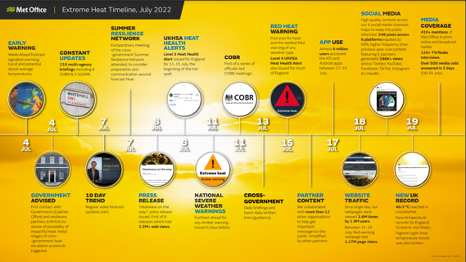Campaign showcase: Extreme heat communications, Met Office
This case study is part of our Government Campaign Showcase series. If you have a government communications campaign that you would like us to showcase, get in contact at GCS@cabinetoffice.gov.uk

Unprecedented weather conditions
From 16 to 19 July 2022, the UK experienced a brief but unprecedented heatwave, which saw the Met Office issue the first ever Red Warning for exceptional heat as temperatures reached 40°C.
Impacts across the country were extensive, including disrupted transport and power networks as well as increasing strain on emergency services. However, impacts were minimised greatly due to early warnings shared with organisations and the public, due to the Met Office communications team being prepared.
Our main communication objective was to make the public aware of the upcoming extreme heat, and to give them the information they needed to stay safe. We wanted our messages to be as far-reaching as possible, ensuring people were aware of the risks associated with extreme heat.
Our strategy was to inform the public of the dangers of extreme heat well in advance, to provide them with the information required to enable them to take action. We opted for a dual approach in our communications:
- to work with partners and stakeholders, including the Cabinet Office, to deliver a consistent cross-government message about the risks and potential impacts surrounding the heat
- to reach our audience directly through our own content, both through our owned channels or via the wider media. Capitalising on our expertise in the wider media positioned us as an authoritative voice
Our work with the Cabinet Office began at the beginning of July by advising the possibility of extreme heat that posed a public health risk, ultimately leading to a COBRA meeting declaring a national emergency. Ongoing briefings with partner agencies meant information was updated and shared regularly.
Informing the public of the danger

Our digital channels provided a platform to share a higher volume and range of content than usual, while our daily emails updated journalists with the latest information.
Our press office was on hand to take calls and coordinate interviews, offering consistent and helpful information and providing expert spokespeople. We also worked alongside partners by including them in content and sharing across our channels.
Our strategy was to inform the public of the dangers of extreme heat well in advance, to provide them with the information required to enable them to take action. We opted for a dual approach in our communications:
- to work with partners and stakeholders, including the Cabinet Office, to deliver a consistent cross-government message about the risks and potential impacts surrounding the heat
- to reach our audience directly through our own content, both through our owned channels or via the wider media. Capitalising on our expertise in the wider media positioned us as an authoritative voice
Our work with the Cabinet Office began at the beginning of July by advising the possibility of extreme heat that posed a public health risk, ultimately leading to a COBRA meeting declaring a national emergency. Ongoing briefings with partner agencies meant information was updated and shared regularly.
Our digital channels provided a platform to share a higher volume and range of content than usual, while our daily emails updated journalists with the latest information.
Our press office was on hand to take calls and coordinate interviews, offering consistent and helpful information and providing expert spokespeople. We also worked alongside partners by including them in content and sharing across our channels.
Reaching those who were most affected
The results of our campaign are demonstrated through the number of people the warnings reached:
- our webpages were viewed 3.6 million times by 1.9 million users in a single day, and between 11 and 19 July our Red Warning webpage had 1.17 million views.
- our live content generated 186K+ views across social media platforms, while our Facebook adverts reached 2 million+ people in warning areas.
- there were a further 41,000+ mentions of the Met Office across print, online and broadcast media. Our ability to capitalise on and drive social interactions gave us a wider platform to share our messaging.
A survey showed that 97% of people in the Red Warning area changed their behaviour to mitigate the effects of extreme heat.
These results show that our messaging was able to reach the people who would be most affected, and also that it encouraged the vast majority of them to act upon our advice.
What did we learn – cross government communication
From evaluating the outcomes of the campaign using the GCS framework, a key learning was the early communication of the warnings for extreme weather gave the public and partners time to take appropriate action. Advising the government early on meant that our messaging was picked up much earlier than it would have had we not alerted partners of the risk to public health.
Cross-agency coordination was also an extremely important aspect of this campaign, as without it the messaging regarding extreme heat could have been inconsistent and ultimately unhelpful to the public when deciding the best course of action to take in response.
Finally, how to capitalise on our owned social channels, as well as driving earned communication has been critical in the success during this period, as the amplification received via engagement from the public and media was critical in our ability to reach those affected.
- Image credit:
- Pexels, Quang Nguyen Vinh (1)
